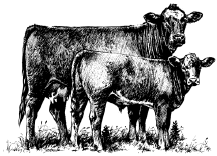

To send a message to an author, click on the author's name at the end of the article.
This Month in Ag Connection | Ag Connection - Other Issues Online
Soybean Cyst Nematode (SCN) is one of the most devastating pests of soybeans in the United States and in the state of Missouri. When SCN infects the roots, soybean plants may appear normal yet suffer significant yield loss. Symptoms which may not appear until infestation levels are very high include yellowing of leaves, plant stunting, and under extreme conditions, plant death. It can be difficult to determine by observation if these symptoms are the result of SCN or another cause such as nutrient deficiencies, herbicide injury or drought stress. After the nematodes hatch, the juveniles penetrate the root and begin feeding. This dramatically affects plant growth by limiting the root's ability to take up nutrients and water. SCN can also affect the number of nitrogen fixing nodules a soybean plant develops.
Once a field is infested with SCN it cannot be eradicated, so it must be managed. If a host crop is not available the nematodes cannot reproduce. This makes crop rotation with a non-host crop one of the best ways to manage SCN. Some non-host crops include: alfalfa, barley, canola, red, white and ladino clovers, corn, forage grasses, oats, rye, sorghum and wheat. Weed control is important in SCN infested fields as some weeds serve as hosts. SCN is spread through the movement of infested soil. Work fields that are not infested before those that are to reduce the potential of transferring SCN on equipment. Clean soil from equipment when moving from one field to another, particularly if SCN is known to be present. Also look for SCN resistant varieties when making seed selections.
Soil can be tested for SCN egg presence and the severity of the infestation. Autumn is a good time to test for SCN because SCN numbers are at their highest levels when plants are almost mature until shortly after harvest. Collect soil samples for SCN in the same manner as testing soil fertility. Randomly collect soil from at least 20 locations in the field using a soil probe or shovel. Soil should be sampled to a depth of eight inches. Large fields should be divided into tracts of 20 acres or less. Mix the soil well and put approximately one pint of soil into a plastic bag. Keep the sample out of the sunlight and excessive heat. Do not let the sample become too dry. Mail samples as soon as possible. The University of Missouri plant nematology lab offers SCN egg counts tests for a fee of $20.
More information about SCN can be found in MU Guide 4450, Soybean Cyst Nematode: Diagnosis and Management. http://extension.missouri.edu/p/g4450
Source: Valerie Tate, Agronomy Specialist
This Month in Ag Connection | Ag Connection - Other Issues Online
This is the time of year landlords/tenants may be considering terminating leases for one reason or another. There are certain steps to terminate a farm lease. Missouri does not have an official termination date like some neighboring states. This article will discuss the law in Missouri and some critical things to keep in mind.

Written leases - if there is a written lease with a tenant or landlord, there are a couple of ways to terminate it. First, the written lease is for a specific time. For example, "March 1 to February 28," then that lease automatically expires at the end of day on February 28th unless both parties renew it. The second method is to specifically put in the lease terms a timeframe, such as 60 days, where either party may notify the other prior to the date the lease ends. This ensures a tenant time to find other land to farm.
Verbal leases - these are the most complicated leases to terminate. To terminate a year-to-year (sometimes called periodic) tenancy, Missouri law requires written notice be made by the party wishing to terminate the lease to the other party not fewer than 60 days before the end of the lease. (A verbal lease begins when the agreement is made and not when possession takes place.)
Month-to-month tenancies (generally used for housing, but can be used in agriculture for pasture rented by the month) can be terminated with one month's notice in writing. The notice to terminate the agreement must be written, even though the original agreement is verbal. If proper written notice is not given, the other party can enforce another term of tenancy.
Termination letters can be very simple and just state this is notice to terminate the lease. No reason needs to be given but depending on the circumstances a short explanation may be included. Make certain a date is included and sign it. If rent is still owed, include the amount in the letter. It is important to send via registered mail and make the other person sign to receive it.
Following the proper steps in lease termination is important, and can eliminate possible problems and disputes. The following guidesheets contain more details on leases and termination: G520, Verbal Farm Rental Agreements Under Missouri Law, and G426, Farm Lease Agreements. For additional information, contact your local agricultural business specialist.
Source: Karisha Devlin, Ag Business Specialist
This Month in Ag Connection | Ag Connection - Other Issues Online
Much research has been done over the last fifty years clearly demonstrating the efficiency and cost effectiveness of growth-promoting implants in beef cattle. Research has also shown there are no detrimental safety issues in either the implanted cattle or humans consuming beef from implanted cattle.

A study conducted by the National Animal Health Monitoring System in 2007 (2,812 cow/calf operations spread across 24 states) showed that only 9.8% of cow/calf operations implanted "some" of their calves. A small number (5.5%) of farms/ranches with 50 cows or less are using some implanting, and a larger number (26.9%) of farms/ranches with 200 or more cows use some implanting.
Not utilizing implants might make sense if producers have access to "natural" markets, but non-implanted calves have to bring a substantial premium to offset the decreased number of pounds sold. Producers not implanting their nursing calves might want to rethink the management decision as implanting nursing beef calves has shown to consistently improve average daily gain (ADG) from the time of implant insertion to weaning. Producers on average can see 15 to 30 pounds of weaning weight gain due to implanting, which can increase farm profitability. Several research studies have also demonstrated that implanting has no negative effect on reproductive performance of heifer calves when a single implant is used, according to label instructions, at 2 to 3 months of age.
A cooperative study between Kansas State University, The Ohio State University College of Veterinary Medicine, Merck Animal Health, Grassy Ridge Consulting and Superior Livestock Auction was conducted on steer and heifer calves marketed from 2010 to 2013, encompassing 2.7 million beef calves sold in 92 video auctions. Lot sizes averaged 100 head. The study accounted for many variables, but this article focuses on the implants which was one of the items studied.
The sale prices of livestock with and without implants for the time period are listed in Table 1. Decisions not to implant nursing calves for the distinct purpose of receiving an increase in sale price was not supported in this study. Unless well-planned marketing strategies are used to capture a premium for "natural" (or non-implanted) calves, beef producers may receive less revenue from calf sales by not implanting.
Table 1: Effect of implant status on the sale price of beef calves marketed through a livestock video auction service from 2010 - 2013.

Reference: G.M. Rogers, M.E. King, K.L. Hill, T.E. Wittum and K.G. Odde, 2015. The effect of growth-promoting implant status on the sale price of beef calves sold through a livestock video auction service from 2010 through 2013. Prof. Anim. Sci. 443-447.
Source: Wendy Flatt, Livestock Specialist
This Month in Ag Connection | Ag Connection - Other Issues Online

Soil quality can be broadly defined as the capacity of a soil to function. In traditional food production systems, the primary function of a soil has been to produce adequate quantities and quality of food to support a growing population. Recently environmental and ecological awareness has resulted in long term consideration of soil as more than just a medium for root biological growth and livestock production. It is necessary to assess and improve a soil's health, or the capacity of a soil to function within ecosystem boundaries in order to sustain biological productivity, maintain environmental health, and promote plant and animal health through the generations.
Ecosystems that maximize soil organic matter and good soil structure are known to maintain high soil biological functioning, soil health, and plant growth. Soil biological properties that are critical for successful ecosystem functioning and optimum soil health include microbial enzyme activity, microbial abundance, and microbial diversity. Soil microbial diversity may be the most valuable biological component of any ecosystem.
In order to meet the expected growing world population demands, producers are reevaluating traditional management systems of maintaining profitability while combining improved ecological and social sustainability. These changes will require a different, more holistic perspective of agriculture, leading to substantial changes in agricultural crop management systems. The new focus should demonstrate the logic and efficacy of using innovative new soil tillage and crop management practices, such as cover crops, specifically designed to more closely imitate natural ecosystems, resulting in reduced need for herbicides, pesticides and fertilizers, thus reducing farming costs while improving environmental quality.
While these changes may not happen over-night, we must reevaluate our management systems. Soil improvements from these new practices will allow increased precipitation infiltration, resulting in reduced soil erosion, more plant-available soil water (increasing yields), and because water will travel through the soil rather than over it, eroding as it flows, cleaner water will be delivered to surface and subsurface aquifers. Offsite benefits will include increased wildlife habitat, rebuilding of soil attributes known to allow environmentally sound, sustainable plant growth, reduced sediment loads in lakes, reservoirs and rivers, increased rates of groundwater recharge and significantly increased soil carbon sequestration. The work will be done with consideration of, and planning for, increased variability in local weather, with particular emphasis on increasing frequency and intensity of severe thunderstorms and increasing likelihood of late summer plant water deficits.
Finally, increasing soil health has important implications for meeting the management challenges imposed by increased weather variability. Research has confirmed that biologically diverse systems are much more resilient in the face of environmental stresses. Reliance upon current production system during times of increased weather variability, especially increased frequency and duration of drought, is a potential recipe for economic and environmental disaster.
Source: Todd Lorenz, Agronomy Specialist
This Month in Ag Connection | Ag Connection - Other Issues Online

Publishing Information
Ag Connection is published monthly for Northeast and Central areas of Missouri producers and is supported by the University of Missouri Extension, the Missouri Agricultural Experiment Station, and the MU College of Agriculture, Food and Natural Resources. Managing Editor: Mary Sobba.